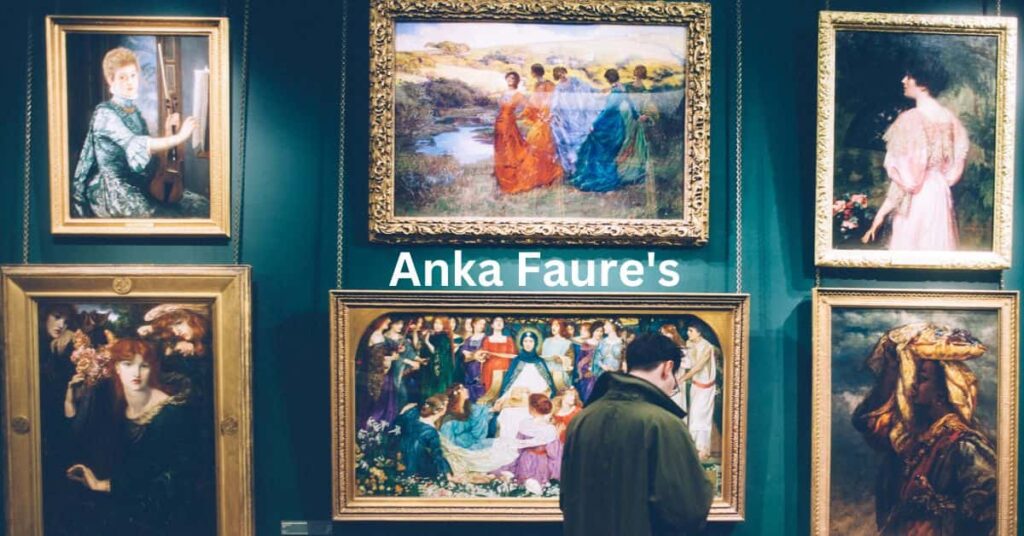
Anka Faure is a great visionary in contemporary art. She is one of the most significant artists of our day because of her striking use of color, abstract forms, and symbolism, which have enthralled art fans worldwide. This blog article will examine Anka Faure’s particular style, highlighting the features that set her work apart and offering advice on applying her methods to your artistic endeavors. We will explore the meaning behind Faure’s complex symbolism and vivid color scheme to learn how to incorporate some of her enchantment into your creative endeavors.
Contents
Anka Faure: A Brief Biography
The world was introduced to the extraordinary French artist Anka Faure in the thriving metropolis of Paris in 1897. Her natural artistic ability was apparent at a young age, setting her on the path to a career in creative expression. Faure received instruction from two well-known artists: André Derain and Henri Matisse. These important people shared their skills and experiences, shaping Faure’s aesthetic sensibility and establishing her style.
Throughout her career, Faure displayed her intriguing artworks at renowned shows like the Salon d’Automne and the Salon des Indépendants. She established her reputation in art by connecting with other artists and fans through these channels. Faure’s creative talent attracted much attention because of her striking use of color and abstract shapes.
Sadly, this remarkable artist left the art world in 1983 when she tragically died in her beloved Paris. Despite her death, Faure’s legacy continues to influence modern artists and art lovers. Her distinct style never fails to enthrall and inspire, making a lasting impression on the art world.
Color and texture in Faure’s work
One of the things that makes Anka Faure’s art so unique is the way she uses color and texture. Her color scheme was defined by earthy, muted tones like brown, green, and blue that were frequently paired with vivid pops of color like orange, red, and yellow. Faure achieved a sense of harmony and balance in her paintings by restricting her palette in this manner.
Faure used color, but he also gave texture a lot of thought. She frequently applied thick layers of paint on the canvas using the impasto technique to evoke depth and movement. She also used collage and other mixed media methods to add depth and intricacy to her paintings.
Faure’s use of color and texture is key to understanding her work. Her use of impasto and collage gives her paintings depth and intricacy, while her subdued color scheme and strong accents evoke a sense of tension and release. Through meticulous attention to these details, Faure was able to develop a distinct, individual style that is instantly recognizable.
Symbolism and abstraction
These two components are fundamental to Anka Faure’s work. She frequently integrates Eastern philosophy and religious symbols into her art and abstract patterns and forms to symbolize feelings and concepts. She can produce paintings that are both striking to look at and thought-provoking.
The use of abstraction in Faure’s art is among its most remarkable aspects. She frequently represents difficult concepts and feelings with simplistic forms and shapes. In her painting “The Song of the Birds,” she describes the various notes of a bird’s song using a sequence of abstract shapes. This allows the audience to hear the birds’ music without actually hearing it.
Moreover, Faure employs symbolism to give her pieces depth and significance. She frequently uses religious and philosophical symbols from the East in her paintings. In her painting “The Lotus Pond,” she employs the lotus flower to symbolize enlightenment and purity. This makes it possible for the observer to connect spiritually with the artwork.
Anka Faure can produce paintings that are both aesthetically pleasing and thought-provoking through the use of symbolism and abstraction. Her artwork challenges the audience to go into their imaginations and consciousness.
Faure’s influence on contemporary art
The distinctive style of Anka Faure has had a significant and enduring impact on modern art. Many artists have been inspired by her daring use of color, abstract shapes, and symbolism to investigate related subjects. Critics also hold Faure’s work in high regard, praising its emotional impact, inventiveness, and beauty.
Faure’s use of color is among her most remarkable artistic qualities. She frequently employed earthy, muted colors like blues, greens, and browns that were juxtaposed with vivid flashes of color. This surprising combination produces an eye-catching and thought-provoking atmosphere of tension and excitement.
Another very inventive usage of abstract forms is by Faure. She generally employs forms and lines to communicate feelings and thoughts rather than representing items literally. This leaves room for interpretation and enables her to produce visually captivating paintings.
Faure is renowned for her use of symbolism in her artwork, in addition to her use of color and abstraction. Her paintings have additional depth and meaning when she frequently uses Eastern philosophy and religious motifs.
Faure’s artwork is still highly prized by collectors and has been shown in galleries and museums worldwide. Her impact on modern art is indisputable, and her creations will continue to motivate artists for a long time.
Tips for incorporating Faure’s style into your art
You can use essential strategies to include Anka Faure’s unique style in your artwork. First, try using strong contrasts in color, emulating Faure’s earthy, muted tones paired with vivid hues. Second, since Faure frequently drew inspiration from nature, include natural elements in your artwork. Thirdly, try experimenting with various textures and mediums, such as collage and impasto, to give your pieces depth and movement.
Lastly, defy convention and try out alternative methods and approaches. Faure’s work was distinctive and engaging because she was determined to push limits and venture into uncharted artistic territory. Using these components in your artwork enables you to produce visually arresting and provocative pieces that honor the legendary Anka Faure.
FAQs
1.What was Anka Faure’s nationality?
French artist Anka Faure was born in Paris in 1897. She trained under the guidance of Henri Matisse and André Derain, and her work was presented at the Salon des Indépendants and the Salon d’Automne.
2.What mediums did Anka Faure use in her art?
Anka Faure primarily worked with oil on canvas and experimented with different techniques, including gouache, watercolor, and printmaking. She was renowned for her symbolic work, abstract forms, and vivid color choices.
3.What is the significance of the symbols in Anka Faure’s work?
Anka Faure used symbols in her artwork, like the yin-yang sign, the lotus flower, and the Tree of Life, found in Eastern philosophy and religion. These symbols frequently stood for feelings, thoughts, or spiritual notions.
4.How has Anka Faure’s work influenced contemporary art?
The distinctive style of Anka Faure has had a significant and enduring impact on modern art. Many artists have been inspired by her daring use of color, abstract shapes, and symbolism to investigate related subjects. Critics also hold Faure’s work in high regard, praising its emotional impact, inventiveness, and beauty.
5.How can I incorporate Anka Faure’s style into my art?
Anka Faure’s style can be incorporated into your artwork in various ways. Adding natural features, experimenting with various textures and materials, and playing with bright and contrasting colors are a few design tricks. Please feel free to defy conventions and try out new methods and approaches.






